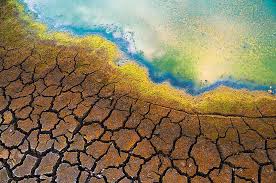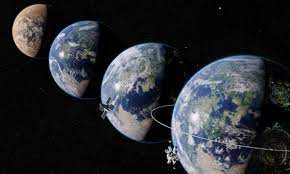In order to have an understanding of the concept of environmental health, one must understand: what the environment is, which normal processes occur in the environment, how man affects his environment and how the various effects of all the activities of man on his environment ultimately affect him.
Natural processes that keep the earth stable
Most people think ‘the environment’ is something “out there” that doesn’t affect us. The environment is where we live and consists of all the living and non-living things around us.
The non-living (physical) part of the environment includes air, water, soil, minerals and climatic factors such as temperature and humidity. The living part consists of all micro-organisms, plants and animals (man inclusive).
Everything we need to live is ultimately provided by our planet and its natural life support systems. If the environment is unable to provide those life support services, then people will suffer.
The next section lists some of the things we can’t do without.
Stable Climate: A stable and comfortable climate is essential for human development.
Protection from ultra-violet radiation our atmosphere, specifically the ozone layer, protects life against the most harmful ultraviolet radiation from the sun.

Ultraviolet light can damage DNA in plants and animals. It is a cause of skin cancers, crop damage and can harm sea creatures
Provision of Fresh water: All the water we have on the Earth now is all the water we have ever had. Most of the Earth’s water is in the oceans (97%) or locked away as ice.
Freshwater is mostly stored underground as ‘groundwater’ (0.6%) and a very small proportion (0.01%) is in lakes, streams and rivers.
Nature provides fresh water continuously, as rain or snow, as the melt- water from glaciers, and by releasing clear filtered water from springs. We tap into natural underground reservoirs of water which have been filtered through porous rocks when we get water from wells
Provision of Breathable air: Wind disperses pollution. Rain washes pollutants out of the air. Plants can trap and filter out pollutants.
When plants photosynthesize (make sugar from carbon dioxide and water) they release oxygen. All of these things help to ensure that animals of all kinds can breathe.
Food webs: Food webs are the complex inter-relations of plants and animals which rely on each other for food. The start of it all is photosynthesis.
Green algae and plants create their own stored fuel by using the energy from sunlight to turn carbon dioxide and water into simple sugars.
This is the basis of the rest of life of the planet, as animals eat the plants or each other, and other organisms eat recently-alive things.
Fertile soils: In most land-based food webs, plants also need fertile soil, which is provided through the erosion of rocks, the rotting of recently-alive things, and the presence of microscopic living things which bind the soil together.
Food: We depend on nature for our food. There are around 270,000 plant species yet only 7,000 (less than 1%) have been used for food by humans.
Fuel: We use a lot of fuel including hydrocarbons e.g. coal, gas and oil. These sources are not renewable. Other sources of include wind and sunlight which are renewable.
Read Also : Complete List of Recyclable Wastes (Waste Recyclables)
Raw materials: We use raw materials for building, clothing, tools and equipment, dyes, books
Medicines: Plants and animals also provide us with medicines such as birth control drugs, antibiotics, cancer drugs, cardiac drugs, anti-malarial and analgesics.
Water recycling,disposal and cleanup: Natural Cycles such as the carbon cycle, water cycle, nitrogen cycle, and phosphorus cycle play a part in neutralizing and filtering waste and pollution.
Over time natural substances break down are digested or eaten by micro-organisms, worked on by water or light, rotted and absorbed in the planet-sized cycles which move carbon, water and many other materials around.
Soil: Soil is crucial to agriculture, the production of many raw materials (from plants and animals) and to the food webs which keep so many of the planet’s cycles functioning.
Soil also plays an important role in storing water and slowing down the speed with which it flows back to the sea.
Biodiversity: Individual species and varieties provide us with resources: food, raw materials, and medicines.

